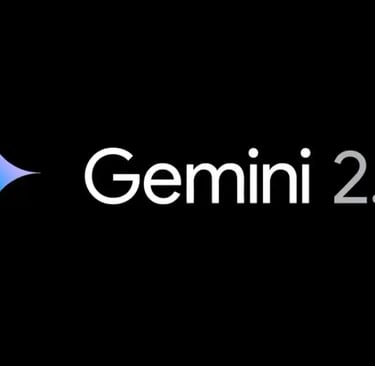Gemini 2.5: Google's Leap into Multimodal AI
This article explores Google's Gemini 2.5, a multimodal large language model capable of processing text, images, and audio
5/9/20253 min read


Introduction
Artificial Intelligence (AI) continues to push the boundaries of what machines can do. In 2025, one of the most groundbreaking developments is Google's Gemini 2.5, a multimodal large language model (LLM) capable of understanding and generating information from text, images, and audio. As the demand for intelligent systems grows across industries, Gemini 2.5 represents a significant leap forward in creating more intuitive and context-aware AI.
What is Gemini 2.5?
Gemini 2.5 is part of Google DeepMind’s Gemini series—AI models developed to bridge the gap between different modes of information processing. While previous models primarily focused on text, Gemini 2.5 integrates multimodal capabilities, enabling it to interpret and synthesize data from various formats simultaneously.
This new model not only reads documents but also analyzes images, listens to spoken input, and generates responses that reflect an integrated understanding of the context. It’s a convergence of linguistic intelligence and sensory perception, bringing machines closer to true human-like reasoning.
Key Features and Capabilities
Multimodal Understanding: Gemini 2.5 processes and links input from text, images, and audio, allowing it to generate richer and more contextually relevant outputs.
Real-Time Interaction: It can interact in real time across different data streams, making it suitable for dynamic environments like live translation or support chat.
Advanced Reasoning: It supports chain-of-thought prompting and can execute multi-step reasoning tasks involving diverse input types.
Contextual Memory: Gemini 2.5 includes improved long-term memory, retaining details across interactions for more personalized responses.
Applications Across Industries
1. Education
Virtual tutors powered by Gemini 2.5 can provide multimodal lessons, combining spoken explanations with visual diagrams and written summaries.
Language learning platforms can use it to simulate real-life conversations involving spoken input and visual cues.
2. Healthcare
Medical AI assistants can interpret patient reports (text), diagnostic images (X-rays, MRIs), and doctor-patient voice recordings.
It can assist with documentation, summarizing patient history and providing predictive insights based on multimodal data.
3. Customer Service
Gemini 2.5 enables voice- and image-enabled virtual agents that offer real-time assistance.
Agents can interpret product images, listen to customer complaints, and respond with coherent, multimedia-based support.
4. Creative Industries
Content creators can use Gemini 2.5 to generate scripts, storyboards, and voiceovers from a single input brief.
It allows artists to describe a scene vocally and receive both a textual description and visual draft.
Comparison with Previous Models
While Gemini 1.5 already introduced efficient handling of long documents, Gemini 2.5 adds new depth by understanding and generating content across media formats. It outperforms previous versions in tasks involving real-world complexity—like interpreting a voice message describing a scene and generating a visual representation with written context.
Compared to competitors like OpenAI’s GPT-4 or Meta’s LLaMA, Gemini 2.5 stands out in its seamless cross-modal fluency and native integration with Google’s ecosystem (Search, Docs, YouTube, etc.).
Ethical Considerations and Challenges
Despite its strengths, Gemini 2.5 raises ethical and operational concerns:
Data Privacy: Handling sensitive health or educational data across modalities requires robust security.
Bias and Misinterpretation: Multimodal data increases the risk of misinterpretation, particularly with images or accents.
Accessibility: Ensuring that the technology is available across languages, regions, and ability levels is critical.
Google has emphasized responsible AI development by building in safeguards, bias checks, and human oversight, but real-world deployment remains complex.
The Future of Multimodal AI
Gemini 2.5 is more than just an upgrade—it signals a shift in how we interact with technology. As AI systems become capable of understanding human inputs in all their complexity, new possibilities emerge:
Ambient AI Assistants: Multimodal models can become ambient assistants that help in daily tasks by observing and interacting naturally.
Human-AI Collaboration: These systems can become true co-creators, collaborating with humans in research, design, and problem-solving.
As multimodal AI matures, it will redefine the interfaces we use to work, learn, create, and connect.
Conclusion
Gemini 2.5 marks a pivotal advancement in AI technology, opening the door to more intuitive, flexible, and responsive human-computer interaction. Its ability to combine language, vision, and audio into coherent understanding and output makes it a game-changer in the evolution of artificial intelligence. As organizations explore its potential and developers build new applications on its foundation, Gemini 2.5 promises to reshape the digital landscape and how we engage with it.
© 2025. All rights reserved.